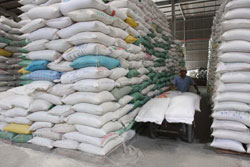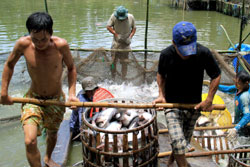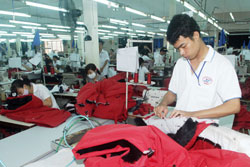Tra fish exporters warned against concentrating upon the US market
Tra fish exporters warned against concentrating upon the US market
Meeting with the big barriers in the EU market, Vietnamese tra export companies tend to head for the US market. However, analysts have warned that this may lead to the overly hot development in the exports to the market.
Nguyen Thi Hong Minh, former Deputy Minister of Fisheries, now the Ministry of Agriculture and Rural Development (MARD), who has returned from a fact finding trip to Mekong Delta, has warned that Vietnamese seafood companies have been flocking to the US market.
“They (seafood companies) told me that they are considering exporting to the US market to offset the decreases in the exports to the EU,” Minh said at a conference held by the Vietnam Association of Seafood Exporters and Producers (VASEP) on June 12.
Minh said that Vietnamese seafood companies now tend to choose the US market since they heard that exporters would enjoy lower tax rates when entering the US market. The lower tax rates have been decided by the US Department of Commerce (DOC) after the seventh administration review (POR7) in March 2012. Besides, the businesses also need to find out other big clients in the context of the sharp demand falls from the EU market.
However, Minh said, the exports in masses to the US market may do harm than good. “Competent agencies need to analyze the situation. The massive exports to the US may trigger anti-dumping lawsuits to be raised by the US farmers’ associations,” Minh said.
“Competent agencies need to appoint their officers to be in charge of examining and supervising the tra fish exports of enterprises,” she continued.
Analysts also think that the risk is obvious, warning that once too many Vietnamese exporters concentrate upon the US market, this may cause a hard pressure to force the prices down in the market.
Deputy Minister of Industry and Trade Nguyen Thanh Bien has agreed that if state management agencies do not take actions soon to intervene in the situation, this may lead to the overly hot growth in the tra fish exports to the US market, which could lead to negative results for Vietnamese enterprises in the next administration review (POR).
VASEP has predicted a bad business performance of seafood companies in 2012. An article published on the official website of the association wrote that the 11 percent growth rate in the first four months of the year and 0.9 percent growth rate in April are the lowest growth rates in the last three years, which can truly reflect the big difficulties of the seafood industry.
Capital and material shortages, plus the increasing input costs and the narrowed export markets all are the big challenges seafood companies are facing. The exports of shrimp and tra fish, the two main seafood export items, have begun decreasing since April. Especially, shrimp exports dropped by 6.5 percent to 163.2 million dollars, and black tiger shrimp exports dropped by nearly 22 percent because of the epidemics and the low demand for high grade products.
Tra fish exports also brought 143.6 million dollars only, a decrease of 0.9 percent in comparison with the same period of the last year. Analysts have warned that the tra fish exports would decrease further, if enterprises and farmers still cannot access bank loans.
The seafood exports to the EU decreased by 12 percent in the first four months of the year, of which shrimp exports were down by 30 percent and tra fish by 14 percent. The growth rate in the exports to the US has decreased by 2/3, though the exports to the market still account for 20 percent of the total exports.
vietnamnet






















